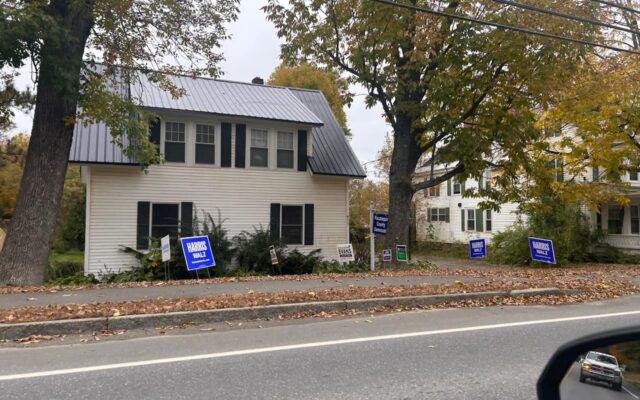
Despite Maine conflicts over political signs, they may not even work
By Jules Walkup, Bangor Daily News Staff
It’s election season, which means it’s almost impossible to go anywhere without seeing political campaign signs in people’s yards or along the sides of roads.
And almost as common as the sight of those campaign signs, it seems, are reports that they’ve gone missing or been vandalized.
In just the last few weeks, campaign signs for Vice President Kamala Harris have disappeared in the midcoast and in Aroostook County, and two vandals were caught on video using their truck to damage an apparent wooden Harris-Walz sign in Dixmont.
Missing Donald Trump signs were found behind Democratic party headquarters in Dover-Foxcroft. And in a more local example from Deer Isle, the ex-wife of a current legislative candidate allegedly stole the signs of a challenger.
There’s no data showing whether more campaign signs are out in Maine this year, or more of them are being messed with. But while the tampering cases usually attract some attention, what often isn’t mentioned is how much of a difference campaign signs actually make.
When signs do help candidates, it tends to be in smaller, more local races that are lower on the ballot, according to Mark Brewer, a political science professor at the University of Maine. That’s because the signs can increase the name recognition for local candidates, and studies have shown they can help move a race by one or two percentage points, which isn’t much, but is still significant.
“Before someone’s going to vote for you, they often want to know who you are, right?” Brewer said. “If I don’t know this person, I’ve never heard their name, I might vote for them based on their party ID, but in a lot of local races, there’s no party listed.”
Conversely, the signs can become less effective at persuading voters to change their minds about more high profile races.
David Costello’s name will appear pretty high on the ballot this year, as he’s a Democrat running for U.S. Senate against incumbent U.S. Sen. Angus King, a left-leaning independent who is heavily favored to win. Also in the race are Republican Demi Kouzounas and independent Jason Cherry.
Costello, of Brunswick, agreed that campaign signs may be the least effective way to encourage people to vote for him, but he has still invested in about 500 of them, in part because they cost less than paid media advertisements, mailers and social media posts, and they’ll at least get people to see his name as they drive by.
“One of the things, for instance, is to put signs in places where you know you’ve got a larger Democratic vote, right? To let people know that I’m on the ballot, or at least it reinforces that once they go into the polls and see me on the ballot as the Democrat, they might say, ‘Oh yeah, I might have seen that person’s sign,’” Costello said.
While Costello has prioritized face-to-face interaction with voters, he said that has turned to those other strategies as well because he can’t possibly meet every voter around the state.
In Costello’s experience, social media has also decreased the relative efficacy of campaign signs, as online posts can reach many more people than a sign on the side of the road.
However, based on Costello’s experience running for other positions or helping with campaigns over the last few decades, he said candidates seem to be putting the same amount of resources into campaign signs today.
Brewer, the political science professor, said social media posts can virtually do the same thing as lawn signs, either with getting out the candidate’s name or signaling that the poster is voting for a specific candidate. But, there are still plenty of people who stick with the “old school” option of a physical sign.
When it comes to the presidential race, though, Brewer said signs are barely effective at changing minds. They mostly serve to signal the beliefs of the person who put them up. For example, if a Harris voter lives in a community where many Trump signs have been placed, they may be less likely to put out a Harris sign, but they will most likely not be persuaded to vote for Trump, either.
“Everybody knows who Donald Trump is, right?” Brewer said. “Even if you’ve been living under a rock for the last 10 years, you know who Donald Trump is. And Harris’s name recognition is probably not as high as Trump, but it’s pretty high. She’s a sitting vice president. She’s the Democrats’ nominee for president. The signs aren’t going to do anything for name recognition there.”
It’s also unclear if campaign signs encourage people to vote in general, Brewer said. While large numbers of them may correlate with higher voter turnout, it’s possible that the signs could be the cause of that enthusiasm, or just a result of it.
For those Mainers putting up campaign signs, state Department of Transportation spokesperson Paul Merrill said it’s important to review rules for where and when they can be placed, to prevent safety hazards and save state road workers the hassle of dealing with violations
Temporary campaign signs can be placed in public rights-of-way for up to six weeks during the first half of the year, and again during the second half. They must be labeled with the owner’s name, address and the date they were placed.
Maine DOT will remove signs if they’re blocking the view at intersections, are made of dangerous material or are placed in areas where they’re prohibited for safety, Merrill said. In that case, the agency will call the owners to ask that they be moved, and if they’re not, it will take them to the nearest state lot.